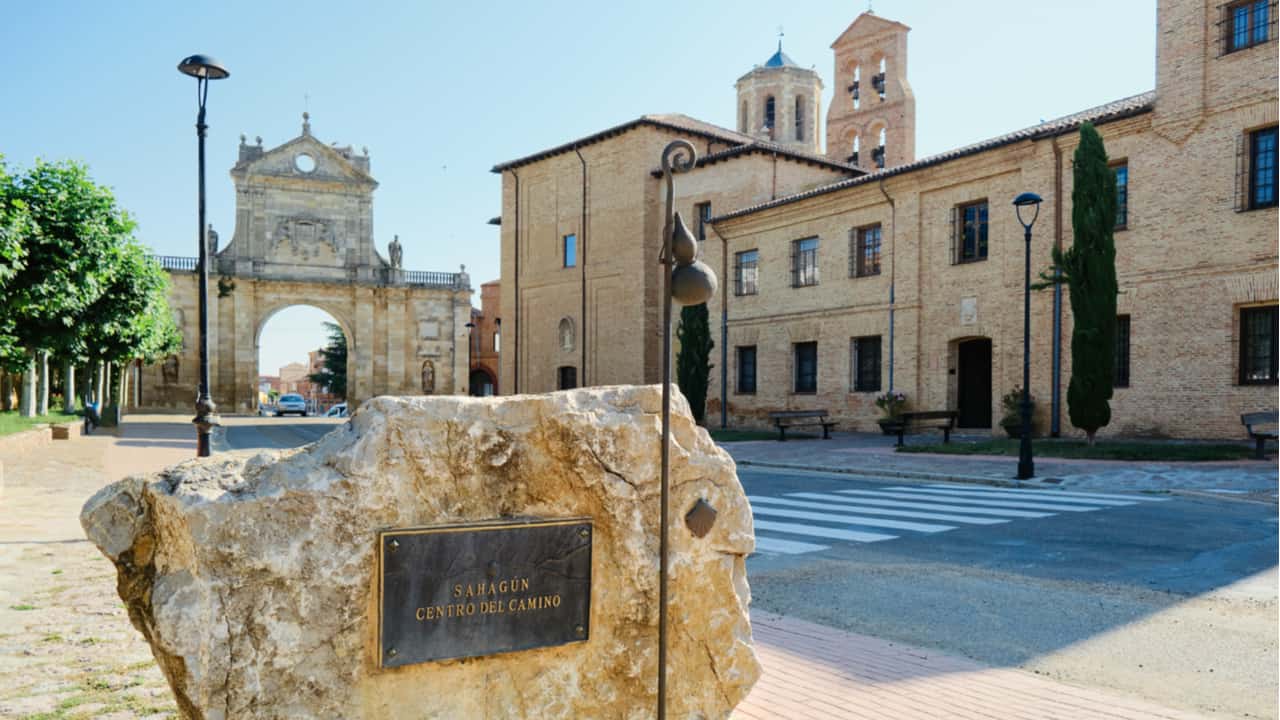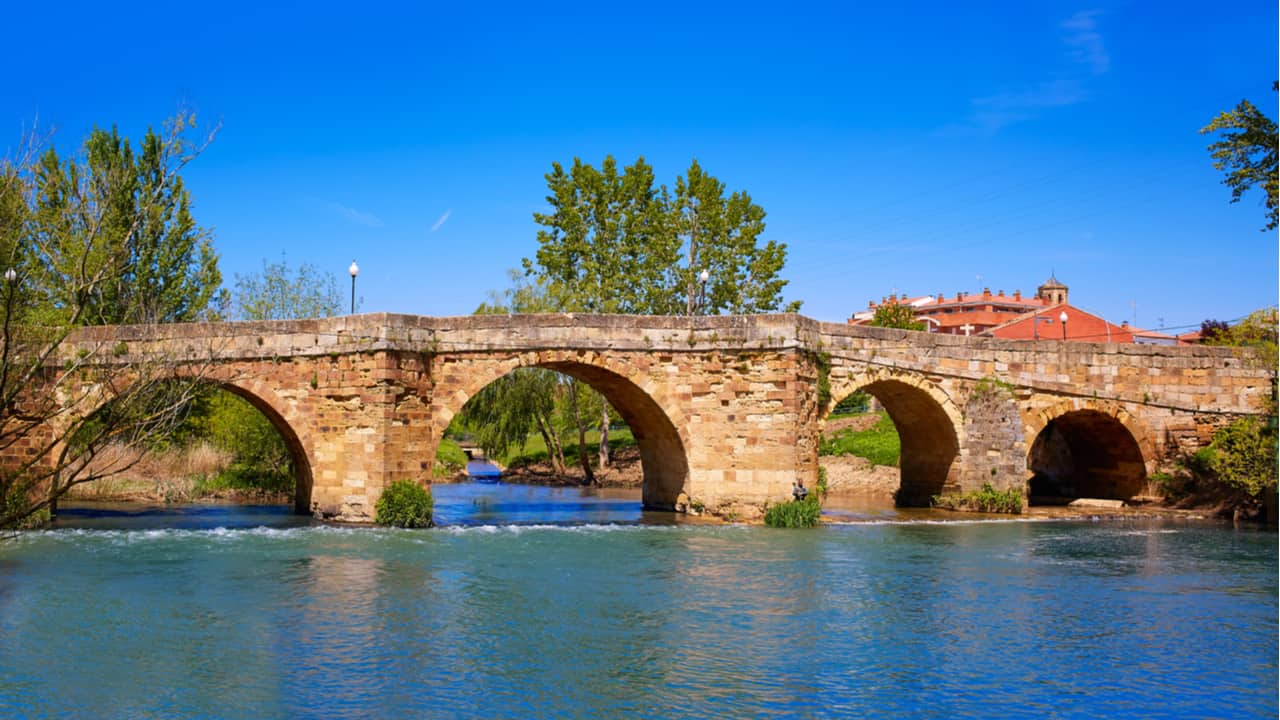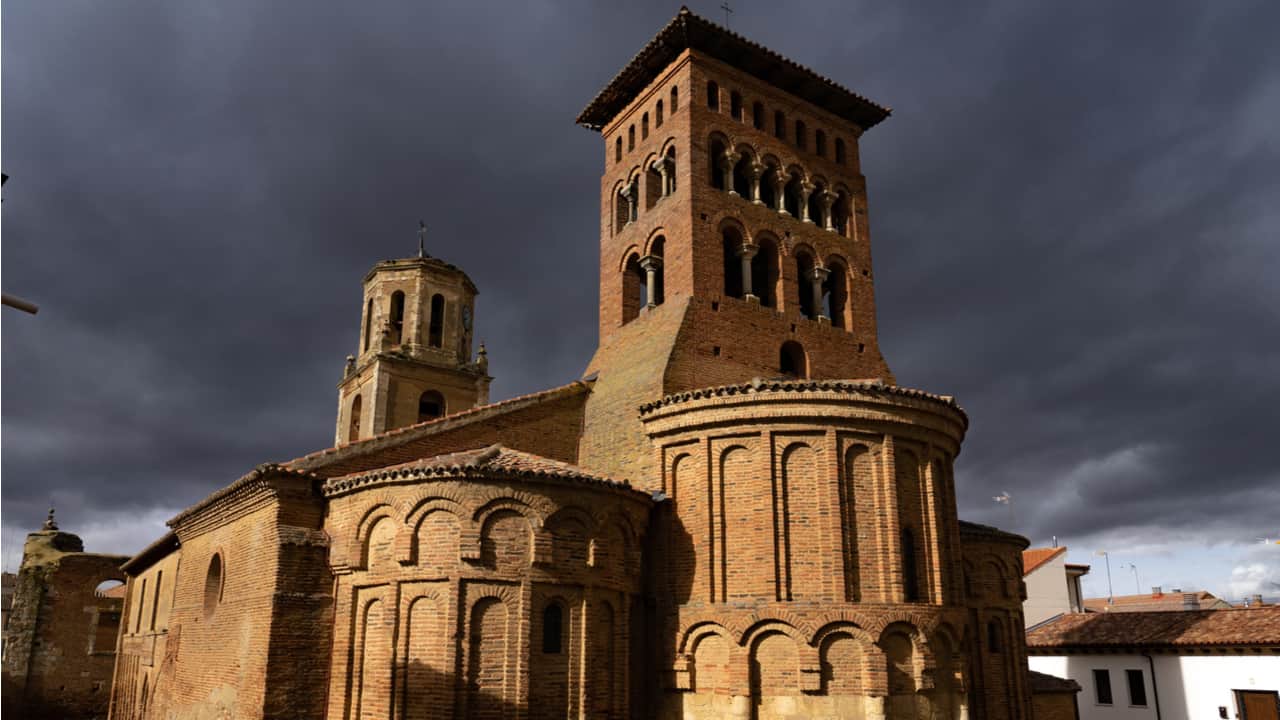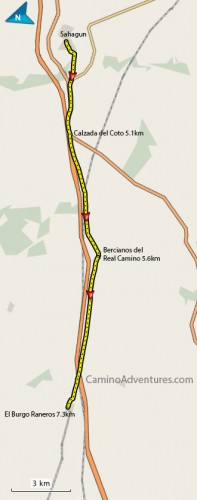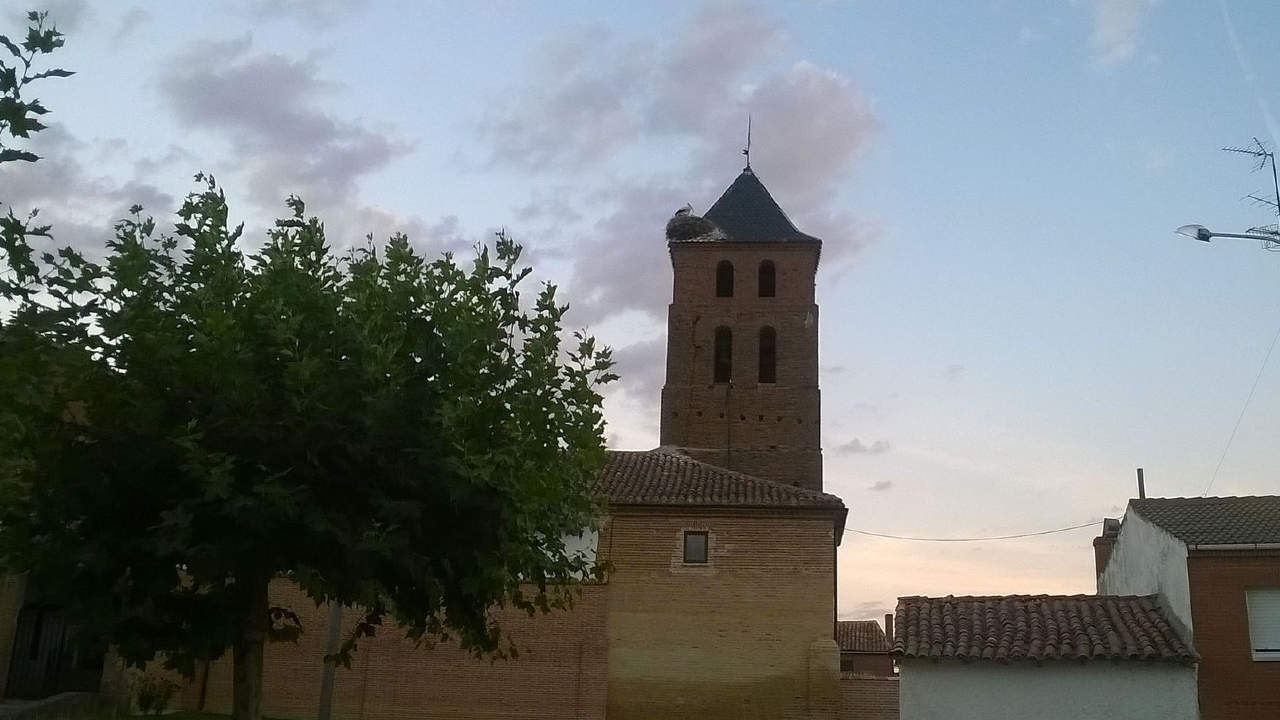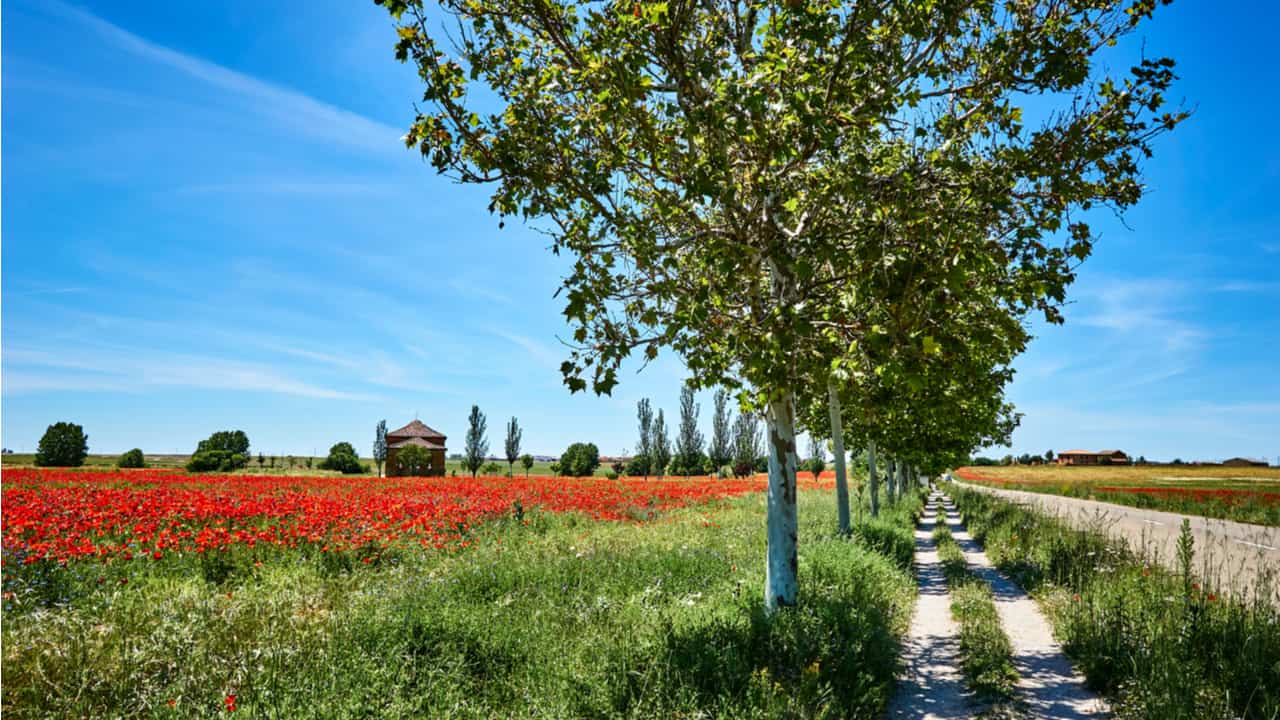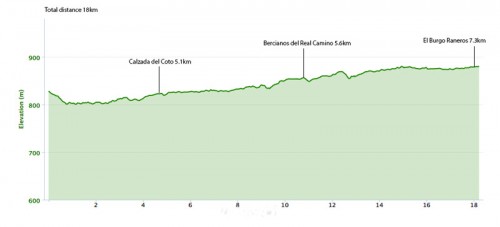The Camino Madrid joins the Camino Frances from the south in Sahagun. Today Sahagun is a small dusty market centre on the Meseta, with a population of less than three thousand, a shadow of its former past.
Sahagun due to its position on the pilgrimage route, and the fact that it’s centered within a rich farming area, was wealthy. Commerce attracted more people to the town and it grew rapidly from the 11th century.
Albergue de Peregrinos Cluny, municipal, Iglesia de la Trinidad, €4, 64 beds, W, D, K, @, Cred, Bike, Tel: 987 782 117, open all year.
Albergue Viatoris, 25 Calle Arco Travesía, private, €7, 50 beds, K, W, D, V, @, M, B, Tel: 987 780 975, www.domusviatoris.com, open March to Oct inc.
Albergue El Labriego, 42 Calle Antonio Nicolás, private, €5, 16 beds, M, @, Bike, Tel: 987 781 057, open unknown.
Albergue de la Madres Benedictinas, Monastery of Santa Cruz. 40 Calle Antonio Nicolas, €7, 16 beds, W, D, @, M, B, Bike, Tel: 987 781 139, , open Apr to Oct inc, double rooms €40, single €30
Most of the Christian and Muslims at that time were farmers that supplied the city. These farmers were poor and could easily lose their land to the monastery due to unpaid loans; there are records of farmers borrowing as little as one bushel of wheat from the Abbey to be repaid after harvest.
However, these small loans were secured on the property and they easily lost their land to the Church which expanded rapidly; at its height, the Abbey controlled more than ninety other monasteries.
Halfway Compostela
A halfway compostela can be purchased at Santuario de Virgen Peregrino where you can visit the museum and walk around the restored convent. The church restoration was completed in 2011 and the building is now an education and cultural center for the Camino de Santiago. It sits on the highest point on the outskirts of the town.
Many of the building in Sahagun were built in the Mudejar style, which is strongly influenced by Moorish taste and workmanship. The style can be recognized quite easily in towers as they often have elaborate and geometric designs. Unfortunately, this style uses brick instead of stone for buildings which does not last nearly as well.
The town takes its name from the place where Saint Facundo and Saint Primitivo were martyred after being betrayed as Christians during the years of persecution under Roman rule. There was a monastery dedicated to the two saints as far back as the 9th century, which was razed to the ground by Moors, rebuilt, razed again, and once again rebuilt – such is the history of Northern Spain.
Once again Charlemagne is associated with the founding of the monastery, however, this is only considered legend; other legends have him as the founder of the town which had been here since Roman times. The patron Saint of Sahagun, St John of Sahagun, along with the children of the nobility, including King Alfonso VI, were educated in the monastery.
Between the 11th and 16th century, it was considered the most important monastery along the Camino Frances, and was run by the Benedictines of Cluny, until the Kings started to favor the monastery San Benito at Valladolid.
This together with the disentailment, freeing of land from the Church, and a devastating fire in the 19th century reduced the monastery to only a 12th century Chapel of San Mancio and the church tower, (often you will come across the monastery erroneously referred to as San Benito).
The Romanesque Mudejar Church of San Tirso, during the 12th century, is typical of this period, however, the portal is 19th century. Inside there is a 13th-century tomb, thought to be one of Alfonso X’s granddaughters. It is worth seeing to note the iconography of the period.
The 13th century Romanesque Church of San Lorenzo contains an important piece that was transferred here from the now-defunct monastery: the Capilla de Jesus is a 1730 retablo by Juan de Juni which is worth at least a few minutes of your time.
The Neoclassical Chapel of San Juan de Sahagun houses the urns with the remains of Saints Primitivo and Facundo.
Today’s Walk: 18 km (11.3 mi)
Today there is a choice of two routes after the first 5 km (3.1 mi) at Calzada del Coto. The least traveled of these turns off to the right in the village towards Calzadilla de los Hermanillos (For details of the minor route see bottom of the page).
The main signposted way is a purpose-built route for pilgrims by the regional government of Leon. This route is shaded by plane trees.
Although there are not many stops along this route, it does pass through some villages. This is the better route to take unless you are very fit and are carrying enough water and food for the whole journey.
Both routes are almost flat and the walking in generally very easy, there are no hard hills at any point on today or tomorrow, also there are few sights to see.
On the way out of Sahagun you cross the Puente de Canto which was first built in 1085 to aid pilgrims. You emerge on the other side at the “Field of Charlemagne’s Lances”, which is now a grove of popular trees and the sight of the following legend.
Charlemagne was chasing Aigolando, the Saracen caliph, with the intention of liberating the way for pilgrims to Santiago. Soldiers were preparing for battle the following day and some left their weapons thrust into the ground upright ready for battle the next day.
At daybreak the soldiers that were to receive the honor of martyrdom found their lances covered in bark with branches growing from them. This miracle was attributed to God; they cut the lances down and from the roots of the lances grew a great wood of plane trees.
Forty thousand Christians were killed in this battle.
We have seen Charlemagne associated with the pilgrimage to Santiago before, it is interesting as Charlemagne died, (814), one hundred years before St James’ remains were found in the Field of Stars.
It is odd today to think of Christians believing in the honor of death in battle for religion against Muslims. However, Charlemagne was a radical Christian who killed many that did not want to convert to Christianity. One example of this was the massacre of 4,500 German pagans at Verden in 782 by decapitation.
My thought today is about persecution; do you? Yourself or anyone else? It is too easy to wander through life with patterns of thought, the Camino is a great place to recognize some of these.
Calzada del Coto
5.1 km (3.2 mi) water, bar, shop
Albergue San Roque, Calle Real, municipal, donation, 24 beds, W, K, @, Bike, Tel: 987 781 233, open all year.
Calzada is another small sleepy Camino village that you will pass through within a few minutes and likely have little memory of, unless of course you stop for the night.
However, between the 14th and 17th August each year the annual fiesta dedicated to the town’s patron saint San Roque takes place.
The unremarkable parish Church is dedicated to St Stephen.
About one kilometer before Bercianos on the left is the small Hermitage de Nuestra Senora de Perales, this was once a medieval hospice that helped pilgrims.
Bercianos del Real Camino
5.6km (3.5 mi) water, bar, shop
Albergue De Peregrinos, 11 Calle Santa Rita, association, donation, 58 beds, M, B, Bike, Tel: 987 784 008, open Apr to Oct.
Albergue Santa Clara, 3 Calle Iglesia, private, €10, 19 beds, M, B, W, D, K, @, V, Bike, Tel: 605 839 993, open all year.
Another sleepy town on the Meseta that helps pilgrims along the way.
The local Church of El Salvador is in disrepair, but still in use. Inside there is a Renaissance figure of John the Baptist and a 17th-century tomb of Dona Leonor a local noble.
El Burgo Ranero is a 7.3-km (4.3 mi) walk from Bercianos del Real Camino, and it has all services.
Minor Route: Sahagun to Calzada del Coto 5.1 km (3.2 mi). Then Calzada to Calzadilla de los Hermanillos 9 km (5.6 mi). You then have the choice of staying overnight and walking the direct route to Mansilla de las Mulas tomorrow, which is 25 km (15.5 mi) with no villages or water, or walking 6 km (3.7 mi) along the road to El Burgo Ranero.
Albergues in Calzadilla de los Hermanillos:
Albergue De San Bartolomé, 28 Calle Mayor, municipal, donation, 16 beds, @, W, D, K, Tel: 987 330 047, open all year.
Albergue Via Trajana, 27 Calle Mayor, private, €15, 20 beds, W, D, M, B, @, Bike, Tel: 987 337 610, , open Mar to Nov inc.
Key: W = Washing, D = Drying, M = Menu, @ = Internet, K = Kitchen, B = Breakfast, V = Vending, Cred = Credential, Bike = Bike Storage
Does this page need any updates or new albergues added? Please let us know in the comments below.

I love hiking, backpacking, and camping. From the Camino de Santiago to the West Highland Way in Scotland or simply a great day hike on the weekend. Hiking refreshes me, my mind, and keeps my body reasonably fit. So far I have walked three Camino routes and many other long distance hikes in the UK, Canada, and around the rest of Europe. One of the best was my hike up Ben Nevis.

